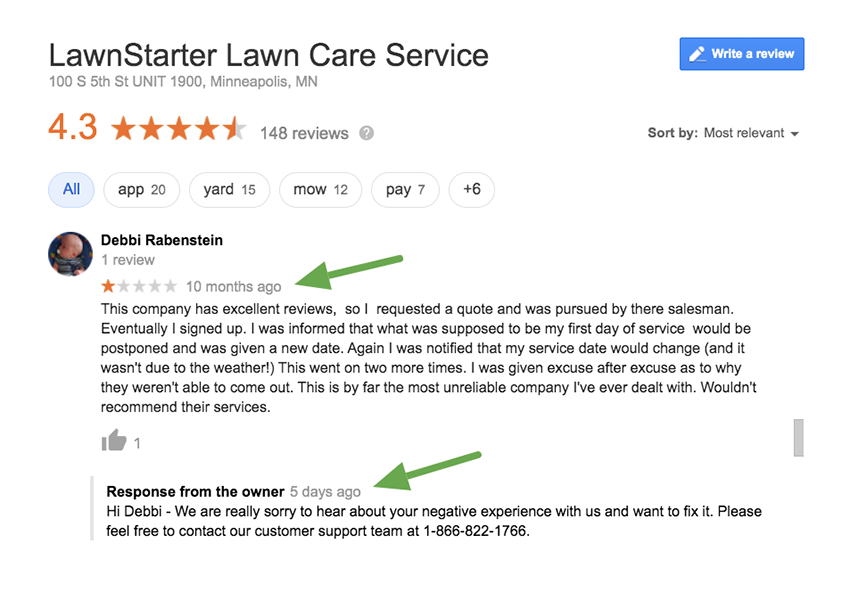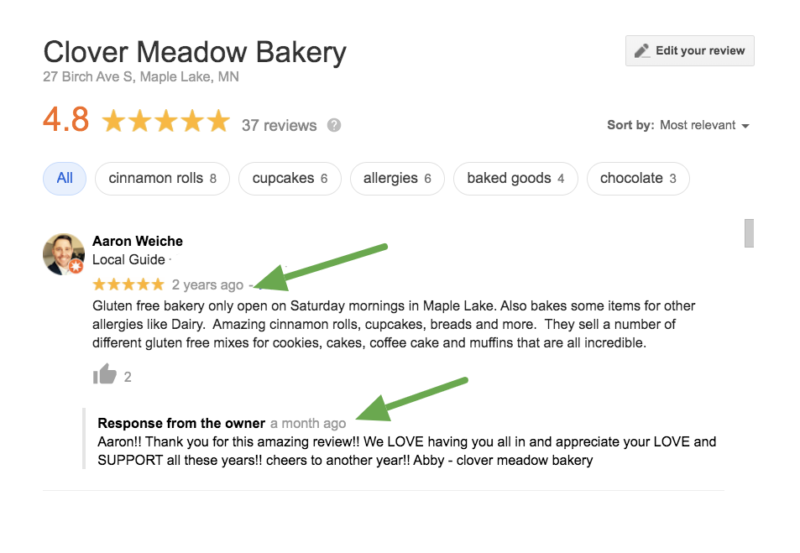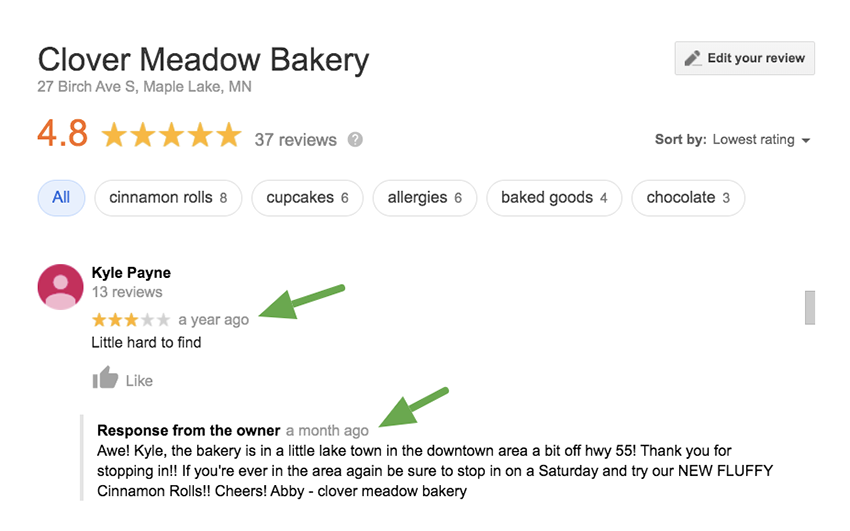It’s important to respond to reviews on Google, whether they’re positive, negative, or neutral. But, if you’re new to managing reviews, you might have some older reviews on your business profile.
So, what’s the best way to handle old online reviews?
How you respond should consider what the customer said and when they said it. Ahead, we’ll share when it’s appropriate to respond to an old review and provide some tips for doing so effectively.
What Are The Benefits of Responding to Old Google Reviews?
Surprisingly, 75% of businesses don’t respond to any of their reviews. So why should you bother? Because by doing so, you join the select group of businesses that value their customers’ opinions.
While there are plenty of benefits of responding to reviews, you get a few additional benefits from replying to old reviews.
- Show prospects you care: 87% of consumers use Google to research local businesses. Replying to old reviews shows new customers you care about their experience.
- Promotes repeat purchases and builds customer loyalty: Replying to customers who left a review months or years ago can remind them of the positive experience they may have had or get them to try your business again if their experience was less than perfect.
Informs your review management strategy: Reading through old reviews and responding to them helps you strengthen your online reputation management muscle. You can use it as a chance to refine your future Google review response plan
Learn more: White label reputation management software for agencies
So let’s get into how to start responding to old reviews — starting with the negative ones.
How and When Should You Respond to Old Negative Reviews?
You should reply to all old reviews, including the negative ones. Hopefully, you only have a handful of bad reviews on your Google My Business account or other review sites. But this may mean going back several years to address customer concerns.
Replying to a negative review on your business account from a few years ago sends a message to customers that you are willing to take responsibility and resolve an issue about a certain aspect of your business.
There’s one exception here––If it’s a hostile review, you may want to leave it. You don’t want to re-engage with a customer like that and cause more problems.
Though replying to your past negative reviews can be time-consuming, you can keep the message short and simple.
Here are a couple of negative review response examples:
“Hi, we’re sorry for missing your review. We are now actively listening to and monitoring our reviews, and we’d like to resolve your issue. Please contact us by (this email) or (this phone number).”
“Hi, we’re sorry we missed your review and that you weren’t satisfied by your experience. We are now actively listening to and monitoring our customer feedback, and we’d love for you to give us another try. We hope to provide a better experience moving forward.”
Here is a 1-star Google review that uses a similar approach. You can see that the review was written 10 months ago, but the lawn care business has just responded in the last week.

Remember, negative reviews can even be a good thing. Even if you can’t recover that long-lost customer it will show your prospects that you are a reasonable, caring business. “Better late than never” are the words of choice when you consider responding to old reviews!
How Should You Respond to Old Positive Reviews?
Responding to old positive reviews requires a different approach. You don’t need to worry about replying to all of the good reviews if you have a lot (which is great, by the way). But if you’re a small business with only a dozen or so past positive customer reviews, it’s best to reply to them all.
The biggest thing here is: Don’t just respond to past 5-star reviews on Google Maps from months or years ago and ignore the negative Google reviews. You should reply to those first!
Thanking a customer for taking the time to share positive feedback, even if it’s years later, is still a great move. Take this example below:
Although a year after the client left the original review, her response probably made that customer smile. It may have also reminded them of their experience and encouraged them to return.
Customers want to feel heard and appreciated. That includes the happy customers, the ones most likely to return. Additionally, responding to positive Google reviews is an opportunity to highlight new products and promote your brand.
Get 100 review reply templates
How Should You Respond to Old Neutral Reviews?
You should reply to old neutral reviews, but you can deprioritize them. If a reviewer simply states something like “It was okay,” there’s not much you can say in response. But, if they provide specific details, there may be an opportunity to share more about your business.
Here’s an example of how to reply to a neutral review:
Showing that you would love another chance and care about their business might encourage them to return when they see your response.
It’s hard to get excited about neutral reviews––even the customer who wrote it probably forgot about it immediately after. So don’t worry if you don’t have time to reply to old neutral reviews.
Instead, you can use the time you saved to improve your system for responding to new reviews.
Improve Your Review Management System and Respond to Old Reviews
Replying to old reviews is a way of reigniting old customer relationships, showing prospects you care, and refining your review response plan going forward.
As you start replying to your old reviews, set up a solid review management plan moving forward. Reputation management platforms like GatherUp can help you by sending new review notifications.
Looking for a quick way to respond to reviews? Our SmartReply feature makes it easy to reply to reviews in seconds. Schedule a demo today.
How To Reply To Google Reviews FAQs
Can Business Owners Delete Negative Reviews on Google?
Business owners can’t delete negative reviews on Google. However, an inappropriate or fake review may violate Google’s contribution policies. In these cases, you can report a review and request review removal to Google. Google’s team will then evaluate whether the review should be taken down.
How Can I Professionally Handle Negative Reviews on Google?
The best way to handle negative reviews is to remain professional, even though it doesn’t describe a positive customer experience.
Here are some tips to answer professionally:
- Respond as soon as possible: People appreciate it when you quickly acknowledge their bad experience. If you’re replying to negative feedback after a while, start with an apology for the delayed response before addressing the issue.
- Be polite and use kind words: Never respond to a negative review, even a rude one, with a negative tone. Your reply is public, and potential customers will see how you treat unhappy customers. This can influence how they perceive they’ll be treated if they have an unsatisfactory experience.
- Empathize with the customer’s perspective: Try to understand why the customer felt the way they did when writing their review. This will help you address their concerns more effectively.
- Offer to discuss the issue further or provide a solution: Customers come to you with a problem, and showing that you care and are willing to resolve it can improve your business’s reputation. It might not increase your star rating but can enhance customer satisfaction
What Should I Include in My Response to a Negative Google Review?
When responding to a negative Google review, your reply should include the following elements:
- A greeting: Start by addressing the person you’re writing to. This sets a positive tone for the rest of your message. For example, “Dear [Customer Name],”
- A sincere apology: At this point, it doesn’t matter who is right or wrong. What’s important is to express regret that the customer had a negative experience with your business. For example, “We are very sorry to hear you had such an unpleasant experience when visiting us.”
- A solution or compensation: Offer a solution, discount, credit, or some other form of compensation. This demonstrates your commitment to retaining the customer and shows others how you handle such situations. Even if the customer doesn’t accept your offer, making the gesture is important.
- A closing and signature: End your response with a closing and your signature or initials. Add your contact information if you want the customer to share more details. This adds a personal touch and reinforces that there is a real person behind the message.

